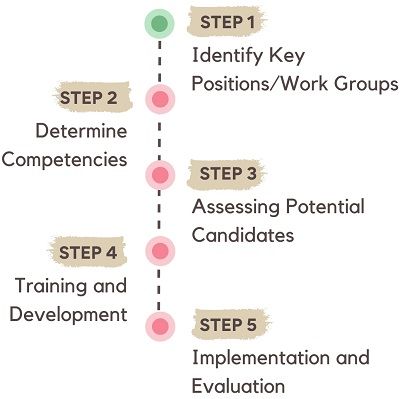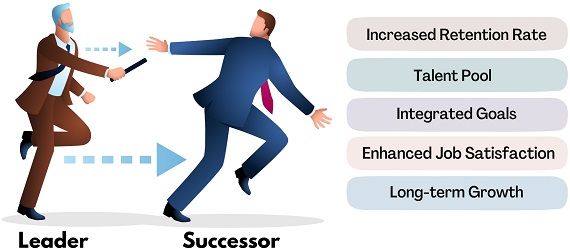Succession Planning is vital for organizations to fulfil present and future staffing needs for key positions. Moreover, organizations try to ensure the supply of the right people at the right job today and in the future.
Human resources have a limited span, after which they leave the organization. There can be several reasons behind their exit, some of which are listed below:
- Leave the organization
- Fired from the job
- Retire from the organization
- Death of the employee
- Switch the job
To survive, organizations need to identify such positions and find a suitable replacement in advance. This way, the organization isn’t affected even if the crucial role gets vacant.

Besides replacement, it focuses on developing employees capable of meeting future business needs.
Through succession planning, organizations can run smoothly without interruptions. Also, they can maintain a continuous flow of talent from within and outside the firm.
It keeps the organization going by creating a pipeline of potential successors. So, organizations keep hiring talented personnel and training them with the required skills and abilities.
Moreover, the employees can build their careers by staying in the organization for an extended period.
In the upcoming sections, we will discuss the process in detail, along with some real-life examples.
Content: Succession Planning
- What is Succession Planning?
- Who is a Successor in Business?
- Example
- Importance
- Succession Planning Process
- 4 Stages
- Benefits
- Succession Planning vs Career Planning
- Best Practices
- Final Words
What is Succession Planning?
It is the systematic process of locating and preparing possible successors who can take up the organization’s current and future key job profiles.
Simply, we can call it a strategy for planning, replacement and transition of leadership roles. Furthermore, it is the mechanism for screening and selecting talent for senior management and leadership.
It ensures the efficiency in the performance of departments, work groups or organizations as a whole.
For example, determining the next CEO of a company or the next Principle for the college.
Objective
The core idea behind conducting succession planning is replacing vital job holders with skilled successors. The organizations perform succession planning with the purpose of:
- Implementing long-term and short-term business plans.
- Create a force of promotable employees.
- Substitute the effects of Downsizing.
- Recruit fresh talent to grow the business.
- Protect and preserve the legacy of the organization.
Who is a Successor in Business?
A successor is someone who is trained to move into the key position when the current occupant leaves.
The majority of the successors are from within the organizations. They are recognized and trained even before the transition occurs. If the current supply isn’t enough, management can hire suitable candidates from outside the organization.
Successors bring a new perspective and fresh ideas that take organizations to greater heights. They also get benefit from this process as they can shape their career in the organization.
Should successors know that they are successors?
The potential successor must be aware of his candidature for the key positions. This is because, they will stay back in the organization and foresee his career growth.
In addition, the current occupant can train the successor to handle critical situations. Also, he can develop the skills and abilities required for the same.
Example
Apple
Each company, whether big or small, do have a succession plan. Apple is the most remarkable example of a smooth CEO transition.
Steve Jobs announced Tim Cook as his successor in August 2011. It was not an overnight decision, but Steve Jobs planned it in advance.
Tim Cook was allotted various job roles in different departments before assisting Steve Jobs. Steve Jobs has also formulated a system that teaches Apple employees to think like him.
Google believes in hiring the best candidates and grooming them for key positions. They have a strong succession plan and prefer internal resources for the same.
Employees see their personal development and career growth within the organization. This way, Google beats its competitors and continues to be on top.
Importance
It is practised everywhere, be it in Politics, Dictatorship or Non-profit Organizations. This is because, every entity needs a skilled and talented successor to get going.
Succession planning facilitates the employment of qualified incumbents in all fields. Hence, the overall system doesn’t get impacted and continues to grow.
The following points explain the importance of creating a succession plan:
- It helps in making the talent pipeline.
- Maintain the goodwill of the organization.
- Predict and prepare for potential events.
- Helpful in setting long-term goals.
- Identify the next and best successor for critical posts.
- Risk mitigation of employee entry and exists.
- Creates a base for the training and development programmes.
- Strengthens organizations for uncertain events.
- Control cost incurred in recruitment.
- Formulate a systematic exit plan.
Succession Planning Process
The process begins by analyzing the skillset of the existing personnel and finding their replacement.
It is a continuous process and is carried out for all critical roles throughout the organization. As, there are many job roles that get filled and vacant every now and then.
Majorly this process is carried out by the HR department. But, they need support and validation from the senior management and stakeholders.
The process may differ across organizations, but the general framework is as follows:

Step 1: Identify Key Positions/Work Groups
Organizations must define key positions & work groups based on criticality and retention risk. After that, identify the roles that need a successor.
Step 2: Determine Competencies
Determine the skill set required for the identified job role. Also, list out the roles and responsibilities that need to be performed by the personnel.
Step 3: Assessing Potential Candidates
Recognize the suitable candidates who are capable of taking up these positions. Likewise, create a pipeline of successors for different roles throughout the organization.
Step 4: Training and Development
Post recognition, train the potential successors to develop the required skills and expertise. Also, try to minimize the gap between the current know-how and expectations.
Step 5: Implementation and Evaluation
At last, review and test the performance of the successors as well as the entire process.
4 Stages
Based on the above framework, four stages can be identified given below:
- Assess: Assess the core positions for succession planning.
- Identify: Find out the potential incumbents.
- Develop: Formulate a talent pool and pipeline of successors.
- Evaluate: Review the performance and efficiency of the successor.
Benefits
Making and implementing a succession plan benefits the organization in the following ways:

- Increased Retention Rate: It motivates employees to stay back in the organization.
- Talent Pool: By continuous succession planning, the organization creates a talented workforce over time.
- Integrated Goals: It integrates organizational goals with individual aspirations.
- Enhanced Job Satisfaction: Better career opportunities and rewards boosts job satisfaction.
- Long-term Growth: The organization grows with new leaders and fresh talent.
Succession Planning vs Career Planning
| BASIS | SUCCESSION PLANNING | CAREER PLANNING |
|---|---|---|
| Meaning | Recognize and train employees to occupy critical roles | Identifying work-life goals to become successful in life |
| Focus | To fill the vacant position | To develop their skill and abilities |
| Growth | Business growth and survival | Individual growth |
| Decision-making | Individual Decision | Management Strategic Decision |
| Management Levels | Generally, conducted for top-level management | Relevant for all levels of management |
Best Practices in Succession Planning
- Perform succession planning activities at the right time and in order.
- Pursue a development mindset for prospecting leaders.
- Develop a talent pipeline and review succession plans very often.
Final Words
A leading organization may also fail in the absence of a doting succession plan. It is just like fuel that keeps the organizations going.
Organizations need successors, even for top-level management like the CEO. Therefore, they must constantly work on their succession plan to have the best leaders on board.
Victoria Addington says
I liked it the most when you shared that the skillset of the existing personnel must be analyzed. My friend told me that their accounting department needs succession planning. I should advise her to turn to a firm with years of experience in succession planning.